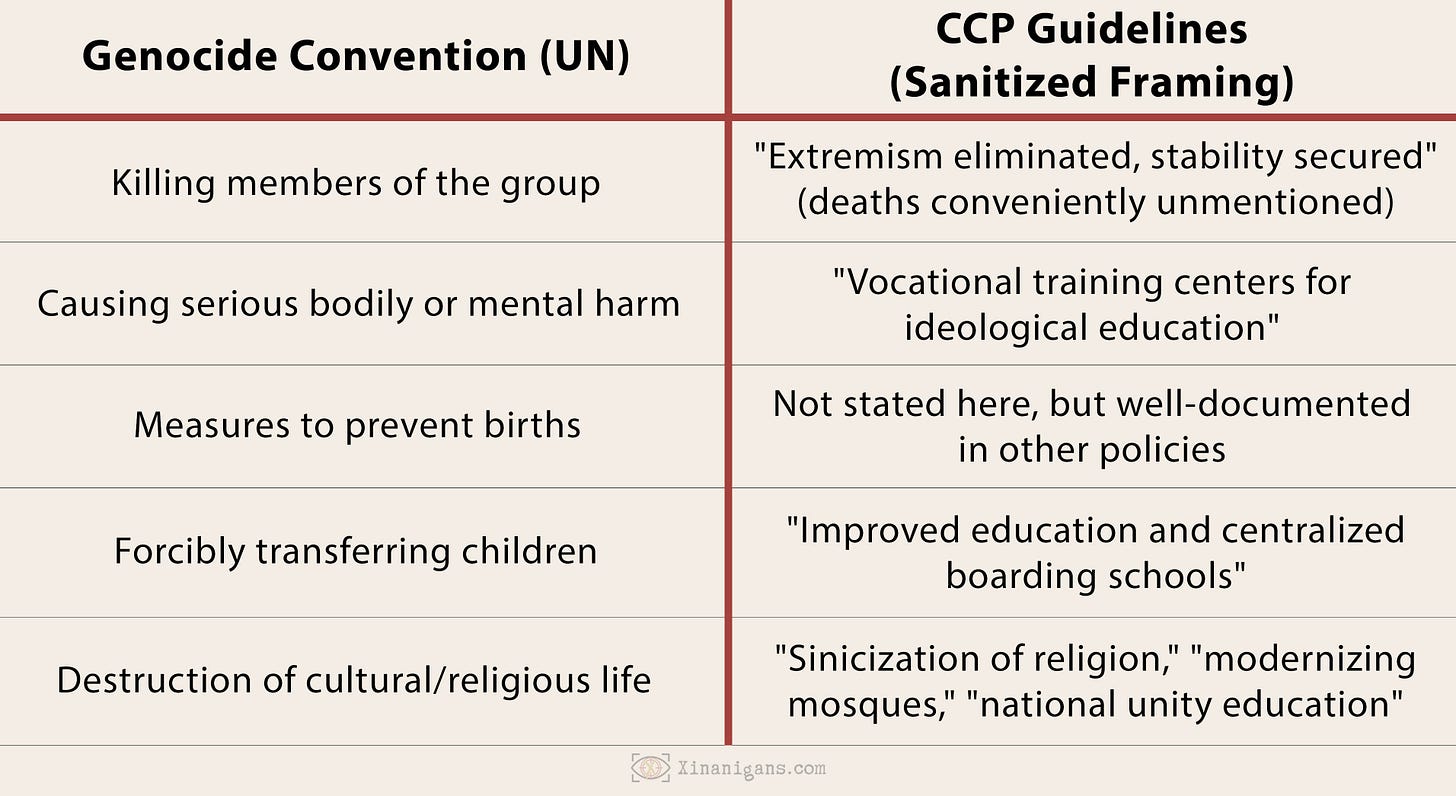Blueprint for Erasure: How the CCP Codified Genocide and Called It Governance
The CCP's recent white paper on Xinjiang is a doctrinal blueprint for global irregular warfare through identity erasure, technological control, and legal warfare.
Editor’s note: All quotes from official guidelines are sourced from the full text of the September 2025 CPC Guidelines for Governing Xinjiang in the New Era. All other supporting claims are hyperlinked in place.
It’s not every day a regime writes a 50-page document explaining and celebrating how it reengineered the identity of millions of people against their will.
But the Chinese Communist Party just did exactly that.
The CPC Guidelines for Governing Xinjiang in the New Era (English translation) functions as a bureaucratic victory lap for one of the most methodical identity erasure campaigns in modern history. Not hidden. Not denied. Codified.
What This Document Is
It serves as a codified justification for internment, surveillance, and cultural suppression, a retrospective rationalization of ethnic and ideological transformation, and a forward blueprint for replicating this model across other contested zones. Rather than hiding the mechanisms, Beijing celebrates them.
These guidelines read like a manual for cultural elimination dressed up as a governance success story. They represent genocide, rebranded as administrative triumph. More critically, they function as a comprehensive irregular warfare playbook, documenting the successful fusion of surveillance technology, legal warfare, economic coercion, and psychological operations into a unified campaign of non-kinetic conquest.
Why This Document Is Unprecedented
1. Denial Abandoned, Victory Celebrated
Most regimes attempting cultural destruction opt for silence, deniability, or plausible misdirection.
Beijing chose publication, celebration, and export strategy.
This document systematically reframes coercive assimilation as “poverty alleviation,” “ethnic unity,” and “social governance modernization.” The Guidelines explicitly celebrate what they term “transformative change in all undertakings in Xinjiang,” including policies that “guide all ethnic groups to have correct views on the country, history, ethnicity, culture, and religion.”
This represents the bureaucratization of ideological eugenics with clinical, administrative language for cultural destruction. Where other authoritarian regimes have tried to hide their crimes, Beijing has turned theirs into a case study for “correct governance.”
In this white paper and Wang Huning’s (the CCP’s chief ideologue and architect of Xi Jinping Thought) interpretation speech, the Party makes this point explicitly: the Xinjiang policies represent “a new height of the CPC’s understanding of the underlying principles in border governance.” This is not about security. This is about doctrine. Xinjiang is framed as proof of Xi’s scientific, effective, and replicable model of civilizational governance.
2. Identity Engineering as State Policy
The entire document revolves around forging what it calls a “Chinese national identity” (中华民族共同体意识). This identity is state-defined (Beijing determines what constitutes legitimate ethnic expression), politically conditioned (cultural practices must align with Party ideology), and culturally homogenized (diversity exists only within narrow, approved parameters).
The Guidelines are explicit about this transformation: “We must focus on fostering a stronger sense of national identity, fully implement the Party’s policies concerning ethnic affairs, and heighten public awareness of ethnic unity and progress.” This priority order, i.e., placing identity transformation before material development, is reinforced throughout the document, which sidelines economic growth as a supporting pillar rather than the goal. Stability, unity, and ideological conformity come first. Development is useful only as a means of controlling and conditioning behavior. The document celebrates policies requiring that “religions in China conform to China’s realities” and emphasizes “Sinicization of religion” and “modernizing mosques.”
Other identities (Uyghur, Kazakh, Hui) exist solely in subordinate, depoliticized forms. The document boasts of establishing “1,555 model units and 2,690 exemplary individuals“ for ethnic unity, revealing the systematic nature of this identity replacement program.
This mirrors historical assimilation campaigns under Stalin and the late Qing Dynasty, but updated with AI-powered surveillance systems, legal warfare frameworks, and international economic leverage.
3. Xinjiang: The Laboratory of Irregular Conquest
The Guidelines adopt strikingly similar language to China’s military irregular warfare doctrine: “standardized, refined, and regular” governance replaces reactive measures; “comprehensive prevention and control systems” predict and suppress instability before it emerges. These phrases mirror PLA information operations and grid-control manuals. This is the language of cognitive and population-centric warfare, deliberately chosen to reflect strategic intent.
The document reveals successful integration of multiple irregular warfare domains that extend far beyond traditional population control.
Legal warfare: The Guidelines detail how “governance in accordance with the law” redefined resistance as “extremism” and cultural preservation as “separatism,” creating legal frameworks that criminalize identity maintenance.
Economic warfare: The Guidelines boast that “over 70 percent of Xinjiang’s general public budget is allocated to safeguard and improve people’s wellbeing,” demonstrating how development aid becomes a tool of political control and dependency.
Information warfare: Comprehensive narrative control through what The Guidelines call “education and guidance to the people of all ethnic groups to strengthen their sense of Chinese national identity,” including the establishment of “471 education bases for patriotism at all levels.”
Technology warfare: AI-driven surveillance creating what The Guidelines term “comprehensive prevention and control system for social security,” with “grid-based governance” that creates predictive suppression capabilities.
The methods tested in Xinjiang are already being exported. Beijing has sold facial recognition systems to over 80 countries, many citing “Xinjiang’s success” in their procurement justifications. Belt and Road partner nations increasingly adopt similar “counter-extremism” frameworks, while China’s state media actively promotes the Xinjiang model as development success to Global South audiences.
CCP Claims vs. The Genocide Convention

The new white paper reframes religious control as a matter of national security: “religious believers must foster a keen sense of national identity, citizenship, and law-based governance.” This elevates Sinicization from a cultural campaign to a pillar of counter-subversion strategy, effectively erasing the line between belief and threat.
While some international lawyers debate whether cultural genocide alone meets the UN Genocide Convention’s formal threshold, the evidence from Xinjiang extends beyond cultural destruction. Documented policies include forced sterilization programs, mass deaths in detention facilities, and systematic prevention of births, meeting multiple Convention criteria for physical genocide alongside the cultural erasure.
The framing is sanitized. The intent is not.
Every mechanism of cultural destruction has been repackaged as administrative progress. It represents perhaps the most comprehensive example of Orwellian doublespeak in modern governance: genocide disguised as development policy.
Beyond Xinjiang: Direct Threats to US Interests
These guidelines constitute operational doctrine with immediate implications for US national security.
It’s a Battle-Tested Playbook for Irregular Warfare
The document teaches Party cadres how to wage non-kinetic campaigns against targeted populations. These methods directly threaten US interests through:
Pressure on Overseas Chinese Communities: The Xinjiang model provides frameworks for political surveillance and ideological pressure campaigns targeting Chinese-Americans, particularly in tech hubs, universities, and business communities. The document’s emphasis on “unity” education and “correct views” signals intensified efforts to police Chinese diaspora political opinions.
Alliance Disruption: Beijing will pressure US allies (especially in Central Asia and Southeast Asia) to adopt similar “governance” approaches, using economic incentives and BRI integration as leverage. Countries that resist will face the choice between Chinese investment and maintaining liberal governance standards.
Information Warfare Expansion: The narrative frameworks tested in Xinjiang are being refined for broader cognitive warfare against democratic societies. The document’s reframing of cultural destruction as “development success” provides templates for defending authoritarian practices globally while undermining US soft power.
It’s a Strategic Template for Future Conquests
Beijing explicitly positions the Xinjiang model as applicable to:
Tibet (ongoing cultural suppression using proven methods)
Taiwan (post-unification governance assuming kinetic success, challenging US deterrence calculations)
South China Sea (population control in disputed territories)
Belt and Road client states (exporting surveillance and political control systems)
It’s Comprehensive Counter-US Strategy
The document reveals successful integration of economic development, surveillance technology, and political control that directly challenges the American model of governance and influence. Beijing has created a replicable system for maintaining control while claiming legitimacy through economic growth, providing a proven alternative to liberal democratic governance for authoritarian regimes globally.
The Party’s Own Words
“We have made historic achievements... and achieved transformative change in all undertakings in Xinjiang.”
— CPC Guidelines for Governing Xinjiang in the New Era
That “transformative change” encompasses mass surveillance networks, religious and linguistic erasure, systematic indoctrination programs, mass internment facilities, forced family separation, and cultural site destruction. The Guidelines don’t deny these actions occurred. Instead, they are celebrated as evidence of successful governance innovation.
Historical Precedents
Nazi Germany’s racial laws and administrative decrees
Stalin’s population resettlement edicts
Khmer Rouge ideological purification manuals
Beijing, however, has added crucial 21st-century innovations: AI-driven control systems for population monitoring, facial recognition and predictive policing for preemptive suppression, and global economic leverage to discourage international criticism.
This represents genocide systematized rather than genocide hidden. Authoritarianism that documents its own crimes and calls them achievements.
The Global Implications
The publication of these guidelines represent a strategic inflection point. Beijing is no longer content to manage Xinjiang quietly. Instead, it’s:
Normalizing systematic cultural destruction as legitimate governance
Exporting these methods as a model for other developing nations
Challenging international human rights frameworks directly
Xinjiang is the proving ground, but the real question is whether the international order will embrace cultural erasure as a viable model of governance.
What Comes Next
The document explicitly frames Xinjiang as a pilot program for broader application. The irregular warfare methods tested there (surveillance fusion, cultural assimilation, ideological saturation, economic coercion) are being refined for global deployment.
For Taiwan, this document provides a comprehensive preview of post-invasion governance. Beijing has essentially published its occupation playbook, assuming kinetic success and focusing on the non-military aspects of territorial absorption. This challenges US deterrence calculations by demonstrating that China has moved beyond invasion planning to detailed post-conflict control mechanisms.
For overseas Chinese communities, particularly in the United States, the document signals intensified ideological surveillance and pressure campaigns. The emphasis on “correct views” and “national identity” suggests expanded political monitoring of Chinese-Americans, especially in sensitive sectors like technology, academia, and defense contracting.
For US allies globally, this represents a direct challenge to liberal governance models. Beijing will offer the Xinjiang template as an alternative to democratic approaches for managing ethnic diversity, political dissent, and economic development simultaneously. Countries facing internal challenges may find this integrated approach attractive, especially when packaged with Belt and Road economic incentives.
The document reveals China’s confidence in having solved the fundamental challenge of modern authoritarianism: maintaining control while claiming legitimacy through development. This creates an exportable model that directly competes with the US-led liberal international order.
The Bottom Line
The CCP has produced what may be the most comprehensive self-documentation of systematic cultural destruction in modern history. They’ve packaged genocide as governance innovation and published it as a model for replication.
But the implications go beyond documentation. This is China’s declaration of irregular warfare capability: its mastery of non-kinetic instruments of control and its confidence in using them to reshape global influence. Beijing has built a cohesive toolkit that integrates surveillance technology, economic coercion, legal warfare, and psychological operations into a unified system of strategic dominance.
The core question for the United States isn’t whether these policies constitute genocide: the evidence is overwhelming. It’s whether America is prepared to confront a rival that has industrialized cultural erasure, branded it as development, and engineered a scalable model of post-liberal governance.
Beijing’s tactics aren’t new, but its posture is. The Xinjiang document outlines a forward-looking playbook for expanding non-military influence into regions where US presence is weak or absent.
As Beijing makes clear: to understand the future of contested territory under Chinese control, look at how it frames its past victories. These guidelines establish a doctrine of irregular conquest, framed as administrative success and positioned for replication. They serve as strategic instructions for extending control, shaping ideology, and exporting China’s model of post-liberal governance. The Party presents them not as defense, but as challenge to the international community before this model solidifies as the new normal.
Got a strategic question or idea worth exploring?
I welcome sharp questions, under-examined angles, and future-post suggestions. Email me directly: inquiries@xinanigans.com



